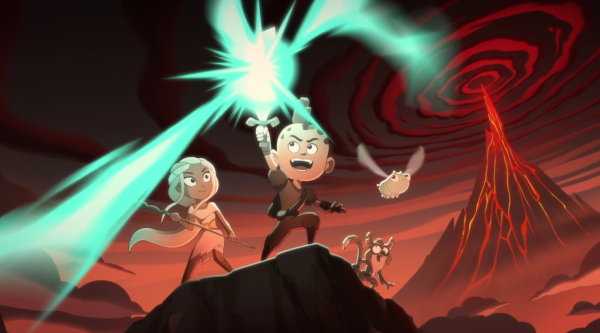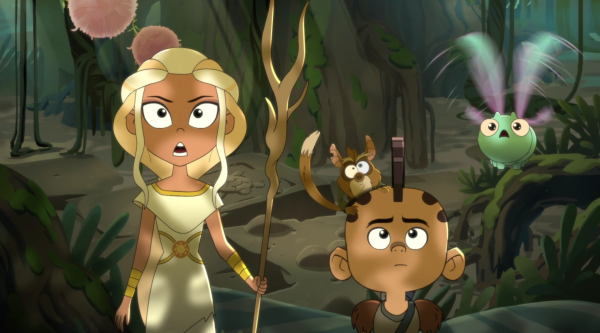Archive for August, 2017
Niko and the Sword of Light Proves Adventure Tales Still Have Merit
Posted by kjohnson1585 in Animation, Television, Uncategorized, Video Games, Writing on August 2, 2017

Niko and his party (which include Princess Lyra, Mandok, and Flicker) run into a stranger in the middle of the first season of Niko and the Sword of Light. The stranger is a talented, effective fighter, a rogue-type mercenary, and he proves to be a better warrior than Mandok. So of course, Niko and Lyra heap praise on this stranger while Mandok stews in jealousy. This stranger makes an important and needed contribution to the team. Every time you think he’ll betray everyone, it turns out to be a red herring. Lulls viewers into a certain set of expectations. But we’re adults, and we’ve seen these kinds of long-term adventure tales before: Lord of the Rings, The Last Airbender, hell, even The Matrix. We know that this stranger will indeed turn out to be a traitor, right as the team is at its most vulnerable. We see it coming, but even still, it’s a striking moment.
It’s a simple moment, too: it’s devoid of any massive complication or overwrought details. There’s depth to the characters, and the world they inhabit, but that depth is important insomuch as it simply provides obstacles and/or methods to overcome them. In other words, don’t expect to delve deep into lore or culture in your fan theories or thinkpieces. But what this does prove is that the basic storytelling tropes of these large, globe-trotting adventure tales can still be effective and powerful and entertaining, especially to younger kids who are new to these kinds of tales. We often forget that there’s an entire demo that hasn’t seen, watched or read these kinds of stories, so they don’t know how to look for the tell-tale signs of betrayal, or homages to Westerns or horror tropes, or the various ways high-end fantasy portrays itself. The twists are obvious but still work, and it helps that the animation is gorgeous, with big, expansive backgrounds and some of the tightest, sharpest action sequences since The Legend of Korra. All to get you into a story that we have witnessed time and time again.
The core of such a story is still engaging though, and Niko and the Sword of Light commits to it in ways that keep it fun and light AND dark and mysterious at the same time. It keeps things moving, a consistent story that manages to keep up along thirteen entire episodes, finding small twists and story beats to maintain that momentum. To be clear, those twists and beats aren’t anything new – besides the aforementioned obvious traitor, there’s the “flawed former hero,” a rally-the-troops moment, temptations galore, and many, many low points before they become inspirationally high. Discerning viewers already on the fence about watching a low-key adventure tale may also be bothered by the show’s humor, which isn’t childish per se, but it is rather basic and simplistic, and at its worst, forced into moments where the dramatic tension is thusly ruined. But there’s a reason these adventure tales are told so often: the wonder, magic, mystery, and action still can delight an audience.

The highest point of the show is its action scenes. Dynamic, vibrant, and engaging, Titmouse has always excelled at crisp, clear, and exciting action, and they bring it to the table here. Watching Niko and Lyra do battle with huge, grotesque monsters is a treat, and it’s both amusing and impressive to watch a ten-year old boy move like a skilled gymnast warrior to dodge massive tentacles or flailing tails. And as great as the monster battles are, the show’s most rewarding fight takes place in episode nine, “From the Cliffs of Catastrophe to the Pools of Destiny” (every location is named in such a fashion, and the show more or less lampshades this convention in many scenes in which characters spout out a series of locales with similar names). Not to spoil too much, but the action here is absolutely wild, arguably the best balls-out battle since the final episode of The Last Airbender. I should also mention that, in a way that’s kind of hard to describe, the action scenes feel very much like you’re actually playing a game – like you’re pressing the buttons to actually perform the specific combos, special “light” moves, and various slick-ass dodges you see on screen. Part of that is because, yes, Niko and the Sword of Light is based on a mobile game of the same name. But it’s also because of how specific Niko’s moveset is, how he moves in action, and how he engages in actual battle. Each swing, each attack, each shouted-out-loud special move feels like an input and has an… aesthetic tactile result and response while watching. I know that saying a show feels like a video game is often negative, but here, it’s absolutely a positive.
And even if Niko and the Sword of Light is mostly a barebones adventure tales with slightly-overwrought gags and tightly storyboard action, there is just enough backend details for those who prefer to read deeper into the world. The various characters that our heroes meet lean a bit on the silly end of their characterizations, but they still feel like a culture with a long history, like the “meercoons,” who have chronicled the failures of past champions over centuries. The central story itself, in which humanity froze itself in safety while guiding said champions over such a long history to fight the darkness, grows more unique and darker over the season, with episode four’s “From the Phantom Woods to the Mountains of Misery” an excellent portrayal of exposition. (It’s even explained why Niko himself is only ten, since the crystal from which he was born was shattered too early, but he still speaks/acts like an older hero, which explains the awkward-sounding dialogue – although I can’t say that Andre Robinson’s VO work isn’t flawless.) The monsters feel like the product of arbitrary “scary” design principles until the main villain, Nar Est, admits that his monstrous creations are just his artistic flourishes. My favorite detail occurs at the Pools of Destiny (episode nine is arguably the show’s best): vague spoilers, but the Pools aren’t what they seem, a product of hyped historical precedent.
And there’s Niko and Lyra themselves. The entire crew grows closer over the course of the adventure but there’s a clear thematic understanding that occurs between the champion and the princess, an understanding that underlies the entire season. Niko’s desire to help all the various groups of people they encounter runs counter to Lyra’s overall goal of reaching and defeating Nar Est. Centuries of failure stem from overall acts of kindness for even the smaller groups of people they meet. When Niko starts to help them, he is the first of a long line of champions to offer assistance for the common person, and it leads to some small but pronounced surprises towards the end. It’s an ending that perhaps culls too much from The Last Airbender and Legend of Korra – two obvious influences, along with Samurai Jack (Nar Est is basically Akku) – but it is satisfying nonetheless, the end result of an adventure story that excels in ways both small and large. I wish the show was deeper and, perhaps, darker, but I also worry that such a direction would force it into a “gritty, serious” state, and that is not a direction that would work for such a show. Still, a bit more depth to some of the specific characters are necessary – like the three “opposterums” whose desperation to stay as a combined, cursed monster really needed exploring – and a better control over the tonal dissonance between its dramatic and comedic moments. The core storytelling is still strong however, and adventure tales like Niko and the Sword of Light still can inspire imagination and wonder in children and adults like the various tales before it.

